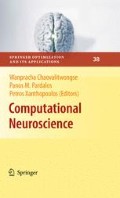Abstract
Transfer entropy (TE) is a recently proposed measure of the information flow between coupled linear or nonlinear systems. In this study, we first suggest improvements in the selection of parameters for the estimation of TE that significantly enhance its accuracy and robustness in identifying the direction and the level of information flow between observed data series generated by coupled complex systems. Second, a new measure, the net transfer of entropy (NTE), is defined based on TE. Third, we employ surrogate analysis to show the statistical significance of the measures. Fourth, the effect of measurement noise on the measures’ performance is investigated up to \(S/N = 3\) dB. We demonstrate the usefulness of the improved method by analyzing data series from coupled nonlinear chaotic oscillators. Our findings suggest that TE and NTE may play a critical role in elucidating the functional connectivity of complex networks of nonlinear systems.
Access this chapter
Tax calculation will be finalised at checkout
Purchases are for personal use only
References
Bharucha-Reid, A. Elements of the Theory of Markov Processes and Their Applications. Courier Dover Publications, Chemsford, MA (1997)
Chen, Y., Rangarajan, G., Feng, J., Ding, M. Analyzing multiple nonlinear time series with extended Granger causality. Phys Lett A 324(1), 26–35 (2004)
Eckmann, J., Ruelle, D. Ergodic theory of chaos and strange attractors. In: Ruelle, D. (ed.) Turbulence, Strange Attractors, and Chaos, pp. 365–404. World Scientific, Singapore (1995)
Efron, B., Tibshirani, R. An Introduction to the Bootstrap. CRC Press, Boca Raton (1993)
Franaszczuk, P., Bergey, G. Application of the directed transfer function method to mesial and lateral onset temporal lobe seizures. Brain Topogr 11(1), 13–21 (1998)
Friston, K. Brain function, nonlinear coupling, and neuronal transients. Neuroscientist 7(5), 406–418 (2001)
Gaspard, P., Nicolis, G. What can we learn from homoclinic orbits in chaotic dynamics? J Stat Phys 31(3), 499–518 (1983)
Grassberger, P. Finite sample corrections to entropy and dimension estimates. Phys Lett A 128(6–7), 369–373 (1988)
Hlaváčková-Schindler, K., Paluş, M., Vejmelka, M., Bhattacharya, J. Causality detection based on information-theoretic approaches in time series analysis. Phys Rep 441(1), 1–46 (2007)
Iasemidis, L.D., Sackellares, J.C., Savit, R. Quantification of hidden time dependencies in the EEG within the framework of nonlinear dynamics. In: Jansen, B., Brandt, M. (eds.) Nonlinear Dynamical Analysis of the EEG, pp. 30–47. World Scientific, Singapore (1993)
Kaiser, A., Schreiber, T. Information transfer in continuous processes. Physica D 166, 43–62 (2002)
Katz, R. On some criteria for estimating the order of a Markov chain. Technometrics 23(3), 243–256 (1981)
Martinerie, J., Albano, A., Mees, A., Rapp, P. Mutual information, strange attractors, and the optimal estimation of dimension. Phys Rev A 45(10), 7058–7064 (1992)
Pawelzik, K., Schuster, H. Generalized dimensions and entropies from a measured time series. Phys Rev A 35(1), 481–484 (1987)
Pereda, E., Quiroga, R.Q., Bhattacharya, J. Nonlinear multivariate analysis of neurophysiological signals. Prog Neurobiol 77(1–2), 1–37 (2005)
Politis, D., Romano, J., Wolf, M. Subsampling, Springer Series in Statistics, Springer Verlag, New York (1999)
Quiroga, R.Q., Arnhold, J., Lehnertz, K., Grassberger, P. Kulback-Leibler and renormalized entropies: Applications to electroencephalograms of epilepsy patients. Phys Rev E 62(6), 8380–8386 (2000)
Sabesan, S., Narayanan, K., Prasad, A., Spanias, A. and Iasemidis, L. Improved measure of information flow in coupled nonlinear systems. In: Proceedings of International Association of Science and Technology for Development, pp. 24–26 (2003)
Sabesan, S., Narayanan, K., Prasad, A., Tsakalis, K., Spanias, A., Iasemidis, L. Information flow in coupled nonlinear systems: Application to the epileptic human brain. In: Pardalos, P., Boginski, V., Vazacopoulos, A. (eds.) Data Mining in Biomedicine, Springer Optimization and Its Applications Series, Springer, New York, pp. 483–504 (2007)
Schiff, S., So, P., Chang, T., Burke, R., Sauer, T. Detecting dynamical interdependence and generalized synchrony through mutual prediction in a neural ensemble. Phys Rev E 54(6), 6708–6724 (1996)
Schreiber, T. Determination of the noise level of chaotic time series. Phys Rev E 48(1), 13–16 (1993)
Schreiber, T. Measuring information transfer. Phys Rev Lett 85(2), 461–464 (2000)
Theiler, J. Spurious dimension from correlation algorithms applied to limited time-series data. Phys Rev A 34(3), 2427–2432 (1986)
Wiener, N. Modern Mathematics for the Engineers [Z]. Series 1. McGraw-Hill, New York (1956)
Acknowledgments
This work was supported in part by NSF (Grant ECS-0601740) and the Science Foundation of Arizona (Competitive Advantage Award CAA 0281-08).
Author information
Authors and Affiliations
Corresponding authors
Editor information
Editors and Affiliations
Rights and permissions
Copyright information
© 2010 Springer Science+Business Media, LLC
About this chapter
Cite this chapter
Sabesan, S., Tsakalis, K., Spanias, A., Iasemidis, L. (2010). A Robust Estimation of Information Flow in Coupled Nonlinear Systems. In: Chaovalitwongse, W., Pardalos, P., Xanthopoulos, P. (eds) Computational Neuroscience. Springer Optimization and Its Applications(), vol 38. Springer, New York, NY. https://doi.org/10.1007/978-0-387-88630-5_15
Download citation
DOI: https://doi.org/10.1007/978-0-387-88630-5_15
Published:
Publisher Name: Springer, New York, NY
Print ISBN: 978-0-387-88629-9
Online ISBN: 978-0-387-88630-5
eBook Packages: Mathematics and StatisticsMathematics and Statistics (R0)

